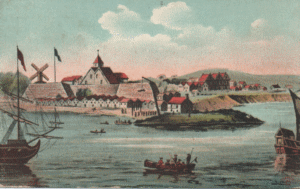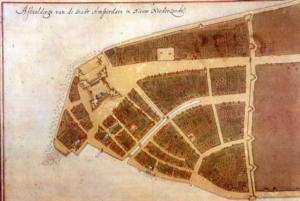 SKC Films Library SKC Films Library |
| SKC Films Library >> American History >> United States: Local History and Description >> Middle Atlantic States >> New York >> New York City |
| New Amsterdam the predecessor to New York City In 1609, Henry Hudson reached what is now known as Manhattan Island and then sailed up the river that now bears his name. Although he was an Englishman, Hudson was employed by the Dutch, so The Netherlands claimed all the territory he explored, including Manhattan. Expeditions by Adriaen Block and Hendrick Christiansz between 1611 and 1614 resulted in the surveying and charting of the region from the 38th to the 45th parallel, which was subsequently named New Netherland. In 1613, Adriaen Block and his crew became the first Europeans to live on Manhattan Island. They built several huts and spent the winter near the southern tip of the island after their ship was destroyed by fire. They built a new ship and left the island in the spring of 1614. In 1620 the Pilgrims sailed to America with a land grant from the Dutch government allowing them to settle at the mouth of the Hudson River. The Mayflower reached Cape Cod (now part of Massachusetts) on November 9, 1620, but a shortage of supplies prevented it from proceeding to the Hudson River and the colonists ended up settling at Plymouth. In 1624, the Dutch West India Company, a private trading firm, sent a shipload of settlers to take possession of New Netherland and to operate various trading posts. The settlers were spread out to Verhulsten (Burlington) Island in the Hudson River, to Kievitshoek (now Old Saybrook, Connecticut) at the mouth of the Verse (Connecticut) River, and to the area around what is now Albany, New York. The threat of attack from other European colonial powers prompted the directors of the Dutch West India Company to plan a fort at the entrance to the Hudson River, and in 1625 several settlers were moved to Manhattan Island. By 1626, the settlers had laid out a town and built Fort Amsterdam at the southern tip of the island. That same year, Peter Minuit, governor of the settlement, bought the island from the natives. The entire settlement was soon renamed New Amsterdam, and the fort became the base for all Dutch fur trade operations in the Hudson River Valley. The colony prospered slowly at first because the governors sent by the Dutch were poor administrators. But, in 1647, Peter Stuyvesant became governor, and under his administration the town began to prosper rapidly. About 1,000 persons lived in New Amsterdam during the 1650's. In 1653, they built a defensive wall along the northern edge of town, but the wall fell down within a few years. The colonists later laid out a road in its place, and that road is still called Wall Street today. Map of New Amsterdam from about
1660 The Netherlands and England fought three naval wars between 1652 and 1674. In 1664, English warships sailed into New York Harbor and forced Peter Stuyvesant to surrender New Amsterdam. The Dutch regained the colony a few years later, but then gave it to England under the terms of a peace treaty. The English renamed the colony New York. The site of Fort Amsterdam is now occupied by the old U.S. Custom House building, which currently houses the Smithsonian Institution's Museum of the American Indian.
SEE ALSO |
| SKC Films Library >> American
History >> United States:
Local History and Description
>> Middle
Atlantic States >> New York >> New York City This page was last updated on June 16, 2017. |

